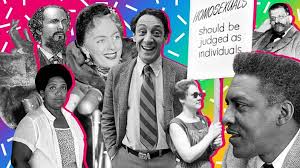As an undergraduate at Temple University, I was a student member of the committee that founded the women’s studies department. It was an exciting time as feminist academics “dis-covered,” in the words of lesbian theologian Mary Daly, our herstory. The group from Temple — two students and two professors — flew to San Francisco for the founding conference of the National Women’s Studies Association. The conference was — outside of the bars — the most lesbian place I had ever been, filled with lesbian academics talking about a new herstorical canon.
I was only 19 and so eager to know more — the confluence of women’s history and queer history always felt inextricable for me. Throughout my time in NWSA, nearly everyone I knew was a lesbian historian. Those collegial friendships imprinted me with the desire to know more about the women who came before me and how they lived their queer lives.
I ache for more of that, now. More history of LGBTQ lives — more details, more depth, more names. Every LGBTQ History Month feels like a recycling of the same famous names we all know. And while those people have a place in our collective history, those names remain overwhelmingly white, male, middle and upper class — the literati and celebrities of their respective eras. There are never enough people of color, lesbians, trans people, and few working-class or poor queers, though that is what most of us have always been.
There are reasons we have more data on some LGBTQ than others: privileged people wrote letters and diaries and so did their friends. Europe was more sophisticated about queerness than America. Famous people gravitated toward each other, while other people less famous wrote about them from an envious distance.
Delving into history takes time and resources. Being a historian is its own privilege. But as a member of the first generation of out queers post-Stonewall, I am painfully aware that our LGBTQ elders are dying out. There are voices we have yet to hear, yet to record, that may be lost forever to us, even as they are still right here in our midst — not a century or two past.
This spring I did a series for PGN on a dozen LGBTQ Philadelphians called The Road to Stonewall. Some, in their 70s, 80s, even 90s, were still alive. Others had been dead for years, but were people I had known — gay men and lesbians with whom I had shared activist work. Writing about them from the vantage point of having met them when I was in my teens and 20s made me so aware of how critical it is to have people of one’s own era and milieu reveal that history.
In high school, I read everything I could find on the Paris lesbians — Natalie Barney, Renée Vivien, Romaine Brooks, Djuna Barnes. My best friend and I would go to New York together for the day. Once we stalked Djuna Barnes to her little apartment in a mews on Patchin Place in Greenwich Village. She took pity on us and invited us in for tea and some dusty biscuits. She was about 80 then, and it was the most exciting event of our young lesbian lives.
In all the years since, I have wished I had taken notes and interviewed Barnes that day or made some plan to return. I wish I had some details of that day in her words, rather than just the slightly rancid tea that left leaves from the torn infuser in my cup or the strange floral flavor of the biscuits or the over-heated damask in the sitting room. Those words — Barnes’ stories of her lesbian youth and her passionate affairs — I ache to have those and never shall, even as the memory of that day remains incredibly vivid.
So many others still among us have stories to tell about the roles they played in their own gay lives — about what it was to live between worlds in the closeted days before Stonewall when it was still illegal to be queer. I came of age as a young teenager in the seedy clubs of the now-thriving Gayborhood in the late 1970s. The butch dykes who took our money at the door and raised their eyebrows at our fake ID, their hair slicked back, their men’s shoes shiny — where were they during the day when I was in high school? What work did their defiant butchness allow them to do? I want to go back in time and interview them, too.
We can all tell our stories — be historians of our personal queer history. But we also need historians who will tell the stories of the less-than-famous, uncover the communities of queers who were living their queer, trans and gender-nonconforming lives before it was accepted, the people who are in their 70s, 80s and 90s now, people in their final chapter who could leave us before we record what it took to be them in the world at that time.
So as we embark on another LGBTQ History Month, seek out the uncommon stories — not just the famous writer cajoled into sharing an afternoon with two swooning teenage lesbians on an adventure, but the butch lesbian who managed the door of a dozen queer bars in the 1950s, 1960s and 1970s, crossing the divide between pre- and post-Stonewall. Our community is rich with stories of our disparate and diverse lives. It’s imperative we mine that history and archive those stories for the generations to come.
